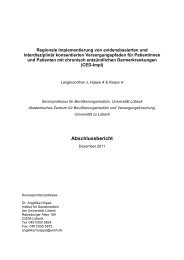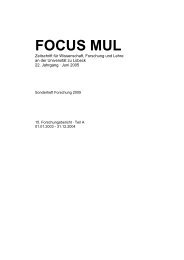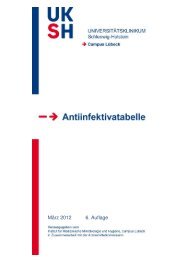Empfehlungen zur kalkulierten parenteralen Initialtherapie ...
Empfehlungen zur kalkulierten parenteralen Initialtherapie ...
Empfehlungen zur kalkulierten parenteralen Initialtherapie ...
Erfolgreiche ePaper selbst erstellen
Machen Sie aus Ihren PDF Publikationen ein blätterbares Flipbook mit unserer einzigartigen Google optimierten e-Paper Software.
<strong>Empfehlungen</strong> <strong>zur</strong> <strong>kalkulierten</strong> <strong>parenteralen</strong> <strong>Initialtherapie</strong> bakterieller Erkrankungen bei Erwachsenen – Update 2010<br />
3. Klinische Chemie der Erguss flüssigkeit<br />
C x: pH unbekannt<br />
C 0: pH > 7,2<br />
C 1: pH < 7,2<br />
Das zusätzliche Risiko für den Patienten<br />
durch einen Pleuraerguss wird anhand der<br />
folgenden Parameter eingeschätzt: Verlängerter<br />
Krankenhausaufenthalt, erhöhte<br />
Morbidität durch Folge-Interventionen,<br />
verlängerte körperliche Beeinträchtigung,<br />
erhöhtes Risiko einer respiratorischen Beeinträchtigung,<br />
erhöhtes Risiko einer lokalen<br />
Entzündungsreaktion, Letalität.<br />
Therapieempfehlung (Empfehlung B):<br />
Kategorie 1 (sehr niedriges Risiko): Vorliegen<br />
von A 0, B x oder C x: keine Drainage<br />
Kategorie 2 (niedriges Risiko): Vorliegen<br />
von A 1, B 0 oder C 0: keine Drainage<br />
Kategorie 3 (mittleres Risiko): Vorliegen<br />
von A 2, B 1 oder C 1: Drainage indiziert<br />
Kategorie 4 (hohes Risiko): Vorliegen von B<br />
2: Drainage indiziert<br />
Für Patienten der Kategorien 3 und 4<br />
scheint eine Entlastungspunktion in aller<br />
Regel un<strong>zur</strong>eichend zu sein. Daher ist die<br />
Anlage einer Thoraxdrainage indiziert. Bei<br />
gekammertem Erguss oder Patienten der<br />
Kategorie 4 sind lokale Fibrinolyse und<br />
videoassistierte Thorakoskopie die am besten<br />
geeigneten Verfahren.<br />
Literatur<br />
1. Abrahamian FM, Deblieux PM, Emerman<br />
CL, Kollef MH, et al. Healthcareassociated<br />
pneumonia: identification<br />
and initial management in the ED. Am J<br />
Emerg Med 2008;26:1-11.<br />
2. American Thoracic Society. Guidelines<br />
of the management of adults with hospital-aquired,<br />
ventilator-associated, and<br />
healthcare-associated pneumonia Am<br />
J Respir Crit Care Med 2005;171:388-<br />
416.<br />
3. Bouza E, Burillo A. Advances in the prevention<br />
and management of ventilatorassociated<br />
pneumonia. Curr Opin Infect<br />
Dis 2009;22:345-51.<br />
4. Bradley SJ, Wilson AL, Allen MC, Sher<br />
HA, et al. The control of hyperendemic<br />
glycopeptide-resistant Enterococcus<br />
spp. on a haematology unit by changing<br />
antibiotic usage. J Antimicrob Chemother<br />
1999;43:261-6.<br />
5. Brito V, Niederman MS. Healthcareasso<br />
ciated pneumonia is a heterogeneous<br />
disease, and all patients do not<br />
need the same broad-spectrum antibiotic<br />
therapy as complex nosocomial<br />
pneumonia. Curr Opin Infect Dis 2009;<br />
22:316-25.<br />
6. Chastre J, Wolff M, Fagon JY, Chevret<br />
S, et al. Comparison of 8 vs 15 days of<br />
antibiotic therapy for ventilator-associated<br />
penumonia in adults: a randomized<br />
trial. JAMA 2003;290:2588-98.<br />
7. Clec´h C, Timsit JF, De Lassence A,<br />
Azoulay E, et al. Efficacy of adequate<br />
early antibiotic therapy in ventilatorassociated<br />
pneumonia: influence of<br />
disease severity. Intensive Care Med<br />
2004;30:1327-33.<br />
8. Dembinski R, Rossaint R. Ventilatorassozi<br />
ierte Pneumonie. Anaesthesist 2008;<br />
57:825-42.<br />
9. Hedrick T, McElearney ST, Smith RL,<br />
Evans HL, et al. Duration of antibiotic<br />
therapy for ventilator-associated pneumonia<br />
caused by non-fermative gramnegative<br />
bacilli. Surg Infect 2007;8:589-<br />
97.<br />
10. Heininger A, Unertl K. Beatmungsassozi<br />
ierte Pneumonie und multiresisten te<br />
Erreger. Anästhesiol Intensivmed<br />
Schmerzther 2007;2:122-9.<br />
11. Höffken G, Lorenz J, Kern W, Welte T,<br />
et al. Epidemiologie, Diagnostik, antimikrobielle<br />
Therapie und Management<br />
von erwachsenen Patienten mit ambulant<br />
erworbenen unteren Atemwegsinfektionen<br />
(akute Bronchitis, akute<br />
Exazerbation einer chronischen Bronchitis,<br />
Influenza und andere respiratorische<br />
Virusinfektionen) sowie ambulant<br />
erworbene Pneumonie. Chemother J<br />
2009;18:189-251.<br />
12. König S, Truwit JD. Ventilator-associated<br />
pneumonia: diagnosis, treatment,<br />
and prevention. Clin Microbiol Rev<br />
2006;19:637-57.<br />
13. Kumar A, Roberts D, Wood KE, Light B,<br />
et al. Duratioon of hypertension before<br />
initiation of effective antimicrobial therapy<br />
is the critical determinant of survival<br />
in human septic shock. Crit Care<br />
Med 2006;34:1589-96.<br />
14. Neuhauser, Weinstein RA, Rydman<br />
R, Danziger LH, et al. Antibiotic resistance<br />
among gram-negative bacilli in<br />
US intensive care units: implications<br />
for fluoroquinolone use. JAMA<br />
2003;289:885-8.<br />
15. Ott SR, Allewelt M, Lorenz J, Reimnitz<br />
P, et al. Moxifloxacin versus Ampicillin/<br />
Sulbactam in aspiration pneumonia<br />
and primary lung abscess. Infection<br />
2008;36:23-30.<br />
16. Paterson DL. „Collateral damage“ from<br />
cephalosporin or quinolone antibiotic<br />
therapy. Clin Infect Dis 2004;38:341-5.<br />
17. Rello J, Vidaur L, Sandiumenge A,<br />
Rodríguez A, et al. De-escalation therapy<br />
in ventilator-associated pneumonia.<br />
Crit Care Med 2004;32:2183-90.<br />
18. Rotstein C, Evans G, Born A, Grossman<br />
R, et al. Clinical practice guidelines<br />
for hospital-acquired pneumonia and<br />
ventilator-associated pneumonia in<br />
adults. Can J Infect Dis Med Microbiol<br />
2008;19:19-53.<br />
19. Torres A, Ewig S, Lode H, Carlet J, et al.<br />
Defining treating and preventing hospital<br />
acquired pneumonia: European perspective.<br />
Intensive Care Med 2009;35:<br />
9-29.<br />
20. Torres A. The new American Thoracic<br />
Society/Infectious Disease Society of<br />
North America guidelines for the<br />
ma nagement of hospital acquired, ventilator-associated<br />
and healthcare-associated<br />
pneumonia:a current view and<br />
new complementary information. Curr<br />
Opin Crit Care 2006;12:444-5.<br />
21. Valencia M, Torres A. Ventilator-associated<br />
pneumonia. Curr Opin Crit Care<br />
2009;15:30-5.<br />
22. Vincent JL. Ventilator-associated pneumonia.<br />
J Hosp Infect 2004;57:272-80.<br />
23. Wall RJ, Ely EW, Talbot TR, Weinger<br />
MB, et al. Evidence-based algorithmus<br />
for diagnosing and treating ventilatorassociated<br />
pneumonia. J Hosp Med<br />
2008;3:409-22.<br />
24. Weber SG, Gold HS, Hooper DC, Karchmer<br />
AW, et al. Fluoroquinolones and<br />
the risk for methicillin-resistant Staphylococcus<br />
aureus in hospitalized patients.<br />
Emerg Infect Dis 2003;9:1415-22.<br />
25. Wenisch C, Laferl H, Szell M, Krause<br />
R. Cefpirom plus Fosfomycin in der<br />
Behandlung von späten Beatmungsassoziierten<br />
Pneumonien. Chemother J<br />
2007;16:182-5.<br />
26. Wunderink RG, Rello J, Cammarata<br />
SK, Croos-Dabrera RV, et al. Linezolid<br />
vs vancomycin: analysis of two<br />
double-blind studies of patients with<br />
methicillin-resistant Staphylococcus<br />
aureus nosocomial pneumonia. Chest<br />
2003;1241789-97.<br />
27. Wunderink RG, Mendelson MH, Somero<br />
MS, Fabian TC, et al. Early microbiological<br />
response to linezolid vs vancomycin<br />
in ventilator-associated pneumonia due<br />
to methicillin-resistant Staphylococcus<br />
aureus. Chest 2008;134:1200-7.<br />
39



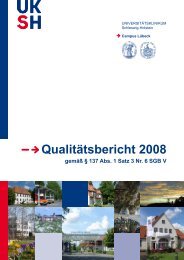
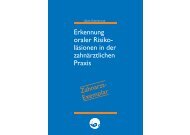
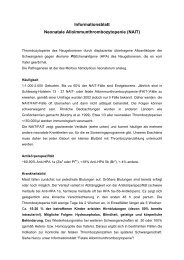
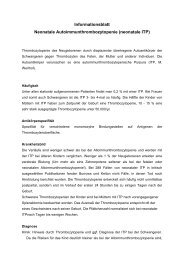
![Ausgabe Januar 2013 [pdf] - UKSH Universitätsklinikum Schleswig ...](https://img.yumpu.com/11131115/1/184x260/ausgabe-januar-2013-pdf-uksh-universitatsklinikum-schleswig-.jpg?quality=85)
![Qualitätsbericht 2011 Campus Kiel [PDF] - UKSH ...](https://img.yumpu.com/9884717/1/184x260/qualitatsbericht-2011-campus-kiel-pdf-uksh-.jpg?quality=85)
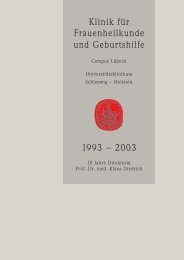
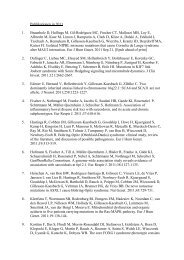
![Interdisziplinäres Symposium Inkontinenz am 24.9.08 [pdf] - UKSH ...](https://img.yumpu.com/7718861/1/190x135/interdisziplinares-symposium-inkontinenz-am-24908-pdf-uksh-.jpg?quality=85)

